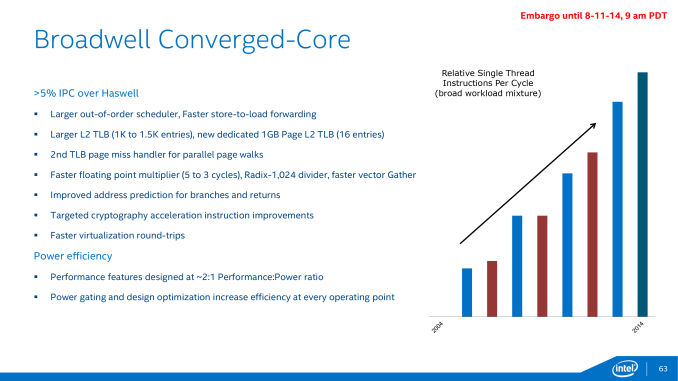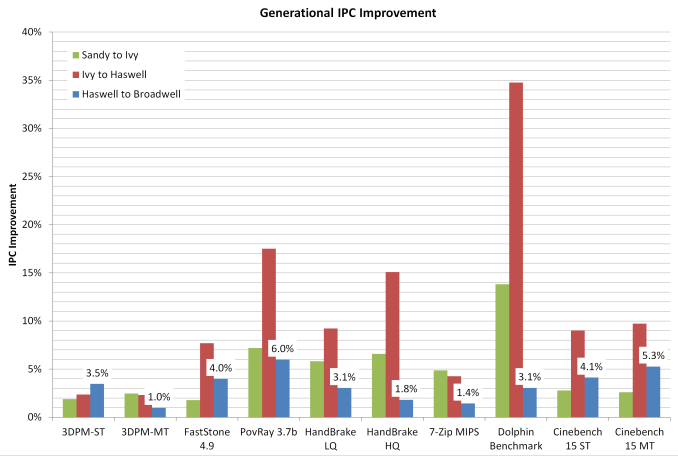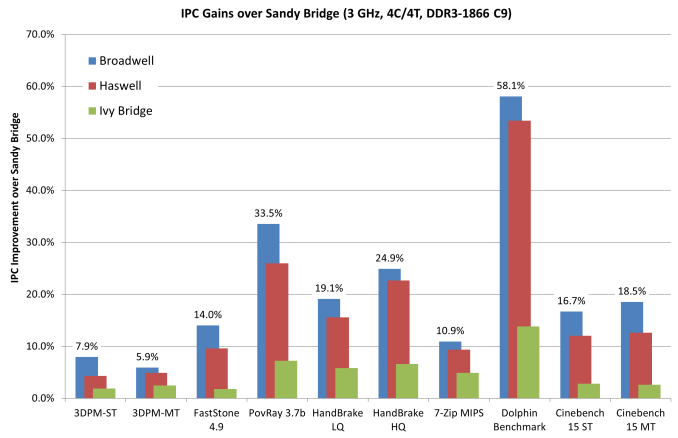The Intel Broadwell Review Part 2: Overclocking, IPC and Generational Analysis
by Ian Cutress on August 3, 2015 8:00 AM ESTConclusions: Broadwell Overclocking, IPC and Generational Gain
For everyone who has been in the PC industry for a decade or more, several key moments stand out when it comes to a better processor in the market. The Core architecture made leaps and bounds over the previous Pentium 4 Prescott debacle, primarily due to a refocus on efficiency over raw frequency. The Sandy Bridge architecture also came with a significant boost, moving the Northbridge on die and simplifying design.
Since then, despite the perseverance of (or soon to be mildly delayed) Moore’s Law, performance is measured differently. Efficiency, core count, integrated SIMD graphics, heterogeneous system architecture and specific instruction sets are now used due to the ever expanding and changing paradigm of user experience. Something that is fast for both compute and graphics, and then also uses near-zero power is the holy-grail in design. But let’s snap back to reality here – software is still designed in code one line at a time. The rate at which those lines are processed, particularly in response driven scenarios, is paramount. This is why the ‘instructions per clock/cycle’ metric, IPC, is still an important aspect of modern day computing.
As the movement from Haswell to Broadwell is a reduction in the lithography node, from 22nm to 14nm, with a few silicon changes, Broadwell was a mobile first design and launched in late 2014 with notebook parts. This is typical with node reductions due to the focus on efficiency overall rather than just performance. For the desktop parts, launched over six months later, we end up with an integrated graphics focused implementation purposefully designed for all-in-one PCs and integrated systems rather than a mainstream, high end processor. The i7 and i5 are both targeted at 65W, rather than 84W/88W of the previous architecture. This gives the CPUs a much lower frequency and without a corresponding IPC change, makes the upgrade path more focused for low end Haswell owners, those who are still several generations behind wanting an upgrade or those who specifically want an integrated graphics solution.
In our first look at Broadwell on the desktop, our recommendation that it would only appeal to those who need the best integrated graphics solution regardless of cost still stands. Part 2 has revealed that clock-for-clock, Broadwell gives 3.3% better performance from our tests although DRAM focused workloads (WinRAR) can benefit up to 25%, although those are few and far between. If we compare it back several generations, that small IPC gain is wiped out by processors like the i7-4790K that overpower the CPU performance in pure frequency or even the i7-4770K which still has a frequency advantage. From an overall CPU performance standpoint out of the box, the i7-5775C sits toe-to-toe with the i7-4770K with an average 1% loss. However, moving the comparison up to the i7-4790K and due to that frequency difference, the Broadwell CPU sits an average 12% behind it, except in those specific tests that can use the eDRAM.
There’s nothing much to be gained with overclocking either. Our i7-5775C CPU made 4.2 GHz, in line with Intel’s expectations for these processors. If we compare that to an overclocked 4.6 GHz i7-4790K, the 4790K is still the winner. Overclocking on these Broadwell CPUs still requires care, due to the arrangement of the CPU under the heatspreader with the added DRAM. We suggest the line method of thermal paste application rather than the large-pea method as a result.
Looking back on the generational improvements since Sandy Bridge is actually rather interesting. I remember using the i7-2600K, overclocking it to 5.0 GHz and remembering how stunned I was at the time. Step forward 4.5 years and we have a direct 21% increase in raw performance per clock, along with the added functionality benefits of faster memory and a chipset that offers a lot more functionality. If you’ve been following the technology industry lately, there is plenty of talk surrounding the upcoming launch of Skylake, an architectural update to Intel’s processor line on 14nm. I can’t wait to see how that performs in relation to the four generations tested in this article.
*When this article was initially published, inaccuracies were made in calculating the IPC gain in the timed benchmarks. The article has been updated to reflect this change. In light of the recalculation,overall conclusions are still correct.
Interesting related links:
The Intel Broadwell Desktop Review: Core i7-5775C and Core i5-5675C Tested (Part 1)
AnandTech Bench CPU Comparison Tool














121 Comments
View All Comments
plonk420 - Wednesday, August 12, 2015 - link
you "blame" AMD?a fuckup warrants "blame." you can't really "blame" someone or some company for not being smart enough to outwit/outperform the competition.
david_tocker - Tuesday, August 4, 2015 - link
I recently upgraded my i7-920 to a Xeon x5670 in the same board. Less power, more performance, same motherboard. Has USB3 - what else do I need?StevoLincolnite - Monday, August 3, 2015 - link
Same situation as you.Got a 3930K... It has happily sat at 4.8ghz just fine for many many years and still gives Haswell-E a good run for it's money. Only paid $500 AUD at the time too!
That is in stark contrast to the 5930K which is currently $860 AUD... Intel has provided me with ZERO compelling reason to upgrade unless I wish to drop down $1500 for the 5960X, which isn't three times as fast as my 3930K.
It's like they don't want my money!
If Intel had released an 8-core 5930K around the $600 mark I wouldn't have thought twice about upgrading, even if the motherboard and memory drove the prices higher.
Also still got a Core 2 Quad Q6600 rig running at 3.6ghz which handles most tasks fine, it's almost 8 years old now, it has certainly paid for itself and still handles most of the latest games fine.
Flunk - Monday, August 3, 2015 - link
I totally agree with you, 6-cores isn't worth bothering with for what Intel's charging. I'm still holding on to my i5-2500k, which does 4.4 all day at 1.2V (and a bit more if you give it a bit more juice).Jetpil0t - Thursday, August 6, 2015 - link
Haven't even bothered to take my 2500k past 4.0 Ghz leaving all the tuning at stock, I remember back in the day I had er up at 4.6 stable with tweaks, but even then it wasn't really a bottleneck. Humming along at 55c max under load @ 4.0Ghz. Most of these CPUs are much hotter thanks to the IGP as well, making Sandy even more enjoyable. Also why would a K series CPU even ship with integrated graphics in the first place.Samus - Monday, August 3, 2015 - link
I still rock a Asus X58 with a i7-950 (used to be a i7-920) back at the office. Never overclocked, completely stable, still completely competitive with modern PC's 7 years later.Obviously it uses more power (130w vs 80w) to a comparably performance-equivalent Haswell Xeon 1230v3 but the difference is a few dollars a year,
hughlle - Monday, August 3, 2015 - link
And I still rock a tock Q6600 and HD 7750. Plays everything that's on the market just fine :)Jon Tseng - Tuesday, August 4, 2015 - link
yeah I still have QX6850 and GTX 970 and it runs all new gaming releases ultra @1080p smooth as butter.I have a suspicion I'm going to get a decade of use out of this Kentsfield, which is completely nuts (and bad news for Intel!)
Bad Bimr - Monday, August 3, 2015 - link
Same here. I have an Asus x58 motherboard with 24GB CL7 memory. Recently pulled the 4Ghz overclocked i7-920 and replaced it with an $85 Xeon X5675 overclocked to 4.6Ghz. My ancient system will hold it's own against most newer systems. Not going to upgrade until Skylake-E or later.xorfish - Monday, August 3, 2015 - link
Go Xeon, those 6 core chips go for 80$ and perform as well as a 4790k in multithreaded tasks.Got mine to 4.0 Ghz for 24/7.
Also 32nm saves you some power...